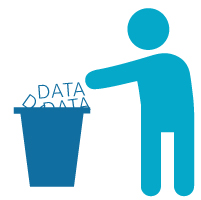
Stop throwing it away.
Storage is cheap, access is easy, so hold on to your data. And don’t store it in structured form, unless you know exactly how you want to extract and use it. Throw it in a data lake, mixing structured and unstructured data together.

Build a team that can analyze it.
This is not easy. Often, new teams of data scientists or analysts come in, but they think differently than other people in the organization, who don’t listen to them. Smart people are only useful if they’re embedded in processes. A big financial firm found this out the hard way, hiring a team of 400 data scientists only to find out they had little impact, which led to a full-scale (and expensive) re-org.

Connect insights to business action/processes.
Insights won’t necessarily come from that PhD at the desk next to you, unless he or she understands the business problem you are trying to solve. You need “tweeners,” people who understand both business issues and how the technology can be applied for analysis. A first step in this direction is to break down the IT silo and embed techies inside business units—and vice versa.
Few firms outside the agile disruptors are taking these proactive steps. When firms do successfully turn data into insight, they trumpet the results, but that often gives a false impression of the real impact under the surface. That doesn’t mean it’s not worth the effort to grab the Holy Grail. Doing so is radically transformative and will put a huge gap between you and the pretenders.






